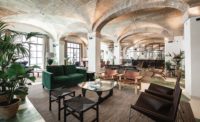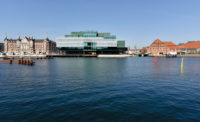Nobis founder and CEO Alessandro Catenacci doesn’t deliberate decisions—he relies on gut instinct. As he did with its five previous incarnations in Stockholm, the head of the hospitality group chose to convert an existing structure for Nobis’s first hotel in Denmark rather than build from scratch. “I like buildings that have added value,” explains Catenacci. “Whether it’s the architecture or the location or just plain sex appeal.” The Gothenburg, Sweden-based firm Wingårdhs has worked with Nobis on several of these buildings, bringing a unique character to each, including the latest, a Neoclassical pile in the center of Copenhagen.
Additional Content:
Jump to credits & specifications
The 1903 structure, long abandoned, was one of the first in the city constructed of reinforced concrete. Built for a wealthy insurance company, it has marble accents, large windows, a majestic central staircase, and soaring ceiling heights. “I loved it instantly,” says Catenacci. Wingårdhs’s elegant but approachable design enhances those features while bringing warmth to the space. And while the exterior’s Italianate appearance is not typical of the city, where gabled brick rowhouses are emblematic, the new interiors pay homage to contemporary Danish design. “We wanted to balance the grandness and richness of the building with soft, welcoming detailing that is nice to the touch,” says Helena Toresson, lead architect on the project.
Wingårdhs maintained the original Carrara marble steps at the main entrance and central staircase, their worn, slightly wavy treads lending a lived-in feeling. The firm extended the staircase—which had terminated at the piano nobile—down to the lower level, replicating the ornate wrought iron of the rail. “We found the only blacksmith in Copenhagen who could do it!” says Toresson.
The lower level, containing the restaurant, kitchen, bar, gym, spa, meeting rooms, and wine storage, is a hub of activity. The dining area is somewhat detached, located within an addition built inside the central courtyard of the C-shaped structure some years ago by a local university that took over the building to house its music academy. Once a lecture hall with solid walls and little glazing, Wingårdhs reclad the exterior of the addition in copper and opened up the interior with extensive windows, including clerestories, so that it is now bathed in daylight. (The only other change to the building’s exterior—which is classified as being “worthy of preservation”—is the addition of two elevator towers on the roof, barely visible from the ground.)
Inspired by a recent visit to Le Corbusier’s La Tourette, Toresson used a similar mullion pattern on the addition’s new windows, echoed also in the room’s wall mirrors and screens. The cheery room features custom tables and sofas—the former in Douglas pine, the latter in a light saddle leather along the walls. By contrast, the nearby bar, within the building proper, is finished in dark Nero Marquina marble.
A cloudy deep gray Bardiglio marble covers every inch of the spa, including its ceiling. “If you’re going to use such a strong material, you owe it to the material that nothing gets in its way,” asserts Toresson. The same marble is used, somewhat less extensively, in the bathrooms of the 77 hotel rooms, which are spread over four floors, including the attic. Ceilings range from 12-feet high on the piano nobile to up to 14 feet on the two floors above it. To fill that tall space, Wingårdhs designed custom beds with posts and canopy frames, topped by mobile-like chandeliers it also designed. In another nod to Le Corbusier, his Lampe de Marseille light fixture adorns each side of the bed.
But the overall design of the rooms has a strong Danish flavor, with saddle leather covering portions of the entry vestibule and select Danish furniture accents by Hans Wegner and others. Floors are oak in a chevron pattern. The intense blues and paler yellow-greens selected for the walls, with a heavy matte finish, were inspired by the colors in the galleries of the Glyptotek, the large sculpture museum located just next door. Wingårdhs designed the tops of the cabinets and mirrors in the rooms to reflect the gently curved windows of the traditional facade. The graphic rugs it created serve as the only art, leaving the colorful walls bare.
Each of the niches within the corridors—some where openings to offices used to be—are embellished with a different vintage lamp from Catenacci’s personal collection (which he wired himself), adding a playful, colorful touch throughout the building. That playfulness culminates in what the hotel calls the “living room,” a casual area near reception for hotel guests to lounge in. The one heavy statement is the reception desk itself, a block of concrete that Wingårdhs designed as an ode to the building’s history.
Wingårdhs, which had previously transformed an Art Nouveau former girls school into the chic Miss Clara, in Stockholm—a youthful choice in the luxurious Nobis portfolio—is currently working with the company to turn a 17th-century palace in Mallorca into a boutique hotel. But at the same time that Nobis has set its sights outside Scandinavia—it is also always looking in Catenacci’s native Italy—its roots are firmly planted in Sweden. Wingårdhs is currently renovating a former warehouse, by Swedish master Sigurd Lewerentz in Stockholm, to become Nobis’ next, more affordable, destination. “Functionalist architecture can be just as spectacular as historic architecture,” says Catenacci. “I like everything that is beautiful.”
CreditsArchitect: Wingårdhs — Gert Wingårdh, principal; Helena Toresson, senior lead architect; Madeleine Müller, project architect
Engineering: Scanding (structural, civil); AI (mechanical)
Consultants: Anker & Co. (lighting); Gade & Mortensen Akustik (acoustics) |
SpecificationsFurniture Carl Hansen & Søn, Gubi, Hay, BassamFellows, Tacchini, Menu, La Cividina, Lammhults, Moroso, Senab, Sarkop, e15
Marble E. Nielsens Mekaniske Stenhuggeri
Hardware Salto, Dorma
Carpets and custom rugs Kasthall
Lighting Nemo Lighting, Vibia, Lambert & Fils, Tekna, Wästberg, Rubn, Senab, Tri West, Morosini, Flos
Elevators MR motech
Plumbing Dornbracht, Unidrain
Paint Jotun |
















